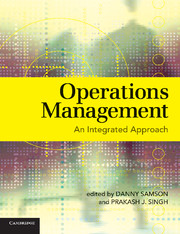Book contents
- Frontmatter
- Contents
- List of Contributors
- Preface
- Acknowledgements
- Part I Operations within Organisations – Building Blocks
- Part II Approaches to Understanding OM
- Part III Moving Forward with OM – Creating Competitive Advantage
- Part IV Challenges and Opportunities in Operations
- Part V Case Studies
- 1 Innovation in the Biotechnology Sector: The Case of IDT Australia
- 2 New Zealand King Salmon: Value-Chain Innovation
- 3 Pilila Clothing Company Goes Lean
- 4 From Singapore to the World: Port Management in Singapore
- 5 Striving for Operations Excellence within Queensland Rail Supply Division
- 6 Should I Stay or Should I Go? Shiraishi Garments Company
- 7 Towards a Green Supply Chain: Toyota Australia
- 8 Process Analyses and Improvement at Bartter Enterprises
- 9 Operations Challenges at Firth Industries Limited, Wellington Division
- 10 Ford Motor Company: Moving Forward in Australia
- 11 Technology Transfer at Hero Honda
- 12 Why Is the Patient Resident Time so Long?: The Case of St Martin's and Charity Private Hospital
- Index
- References
10 - Ford Motor Company: Moving Forward in Australia
Published online by Cambridge University Press: 05 June 2012
- Frontmatter
- Contents
- List of Contributors
- Preface
- Acknowledgements
- Part I Operations within Organisations – Building Blocks
- Part II Approaches to Understanding OM
- Part III Moving Forward with OM – Creating Competitive Advantage
- Part IV Challenges and Opportunities in Operations
- Part V Case Studies
- 1 Innovation in the Biotechnology Sector: The Case of IDT Australia
- 2 New Zealand King Salmon: Value-Chain Innovation
- 3 Pilila Clothing Company Goes Lean
- 4 From Singapore to the World: Port Management in Singapore
- 5 Striving for Operations Excellence within Queensland Rail Supply Division
- 6 Should I Stay or Should I Go? Shiraishi Garments Company
- 7 Towards a Green Supply Chain: Toyota Australia
- 8 Process Analyses and Improvement at Bartter Enterprises
- 9 Operations Challenges at Firth Industries Limited, Wellington Division
- 10 Ford Motor Company: Moving Forward in Australia
- 11 Technology Transfer at Hero Honda
- 12 Why Is the Patient Resident Time so Long?: The Case of St Martin's and Charity Private Hospital
- Index
- References
Summary
Ford motor company – the beginning
The true beginning of the Ford Motor Company will probably never be known as it was born from Henry Ford's relentless efforts to develop a technology that would rapidly replace the horse-drawn carriages of the time and supply motor vehicles to the world. One of the most pivotal points in the history is the first recorded vehicle Henry Ford ever built. Named the Quadricycle, it was constructed at the rear of his and wife Clara's home at 58 Bagley Avenue, Detroit in 1896 (Banham and Newman, 2002).
The Ford Motor Company formally began when the articles of incorporation were signed in Detroit, Michigan on 16 June 1903. At this time Henry Ford and eleven other modern industrialists had a total capitalised sum of $28,000 USD. These funds would lead to the growth and development one of the largest and most successful automotive companies in the world today. Persistence during the early days of incorporation paid off for the Ford Motor Company and the first record of sale was to a Detroit Physician on 20 July 1903, thus the Ford Motor Company began (Brinkley 2003).
From humble beginnings behind his family home, a key differentiating strength of the Ford Motor Company has been its ability to continue to develop new ways of doing things. This pursuit of excellence and continued ability to re-invent itself and move with the times, has helped the Ford Motor Company become a global leader in today's automotive industry.
- Type
- Chapter
- Information
- Operations ManagementAn Integrated Approach, pp. 518 - 526Publisher: Cambridge University PressPrint publication year: 2008



